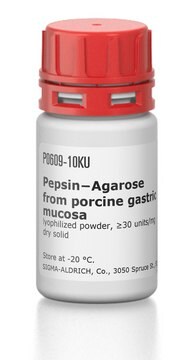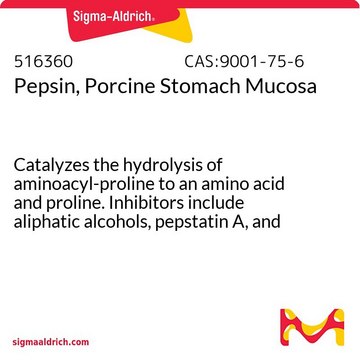10108057001
Roche
Pepsin
lyophilized (salt-free), ~2500 units/mg protein (At 37 °C with hemoglobin as the substrate. One unit is the enzyme activity which liberates the amount of Tyr producing an increase in the absorbance of 0.001/minute at 280 nm.)
Synonim(y):
pepsin
Zaloguj sięWyświetlanie cen organizacyjnych i kontraktowych
About This Item
Polecane produkty
pochodzenie biologiczne
pig gastric mucosa
Poziom jakości
Postać
lyophilized (salt-free)
aktywność właściwa
~2500 units/mg protein
opakowanie
pkg of 1 g
producent / nazwa handlowa
Roche
optymalne pH
1.8-2.2
Warunki transportu
wet ice
temp. przechowywania
2-8°C
Powiązane kategorie
Opis ogólny
Pepsin is an aspartic endoproteinase isolated from pig gastric mucosa. It is mainly used for the unspecific hydrolysis of proteins and peptides in acidic media. It also provides a limited hydrolysis of native immunoglobulins to yield biologically active fragments.
Specyficzność
Aspartic endopeptidase with relatively broad specificity. Preferential cleavage: hydrophobic, preferably aromatic, residues in P1 and P1′ positions.
Zastosowanie
Pepsin has been used for the digestion of liver tissue obtained from rat.
Uwaga dotycząca przygotowania
Working concentration: 0.05 to 0.5 mg/ml
Storage conditions (working solution): A pepsin solution is stable at 2 to 8 °C, at least for one week, at neutral pH and under germfree conditions. Frozen aliquots of the enzyme solution are expected to be more stable.
A stock solution in 10 mM HCl (5-10 mg/ml) should be stable for at least one week at 2 to 8 °C, too. Storage light protected, tightly closed.
A short (2 minutes) incubation at 40 °C has negligible effect on the activity of lyophilized pepsin or pepsin in solution.
Storage conditions (working solution): A pepsin solution is stable at 2 to 8 °C, at least for one week, at neutral pH and under germfree conditions. Frozen aliquots of the enzyme solution are expected to be more stable.
A stock solution in 10 mM HCl (5-10 mg/ml) should be stable for at least one week at 2 to 8 °C, too. Storage light protected, tightly closed.
A short (2 minutes) incubation at 40 °C has negligible effect on the activity of lyophilized pepsin or pepsin in solution.
Komentarz do analizy
At 37 °C with hemoglobin as the substrate. One unit is the enzyme activity which liberates the amount of Tyr producing an increase in the absorbance of 0.001/minute at 280 nm.
Inne uwagi
For life science research only. Not for use in diagnostic procedures.
This page may contain text that has been machine translated.
Hasło ostrzegawcze
Danger
Zwroty wskazujące rodzaj zagrożenia
Zwroty wskazujące środki ostrożności
Klasyfikacja zagrożeń
Eye Irrit. 2 - Resp. Sens. 1 - Skin Irrit. 2 - STOT SE 3
Organy docelowe
Respiratory system
Kod klasy składowania
11 - Combustible Solids
Klasa zagrożenia wodnego (WGK)
WGK 1
Temperatura zapłonu (°F)
Not applicable
Temperatura zapłonu (°C)
Not applicable
Certyfikaty analizy (CoA)
Poszukaj Certyfikaty analizy (CoA), wpisując numer partii/serii produktów. Numery serii i partii można znaleźć na etykiecie produktu po słowach „seria” lub „partia”.
Masz już ten produkt?
Dokumenty związane z niedawno zakupionymi produktami zostały zamieszczone w Bibliotece dokumentów.
Klienci oglądali również te produkty
Ganesan Arunkumar et al.
Science advances, 8(9), eabl5621-eabl5621 (2022-03-03)
Chromosome instability is a critical event in cancer progression. Histone H3 variant CENP-A plays a fundamental role in defining centromere identity, structure, and function but is innately overexpressed in several types of solid cancers. In the cancer background, excess CENP-A
Claus Kordes et al.
The Journal of clinical investigation, 124(12), 5503-5515 (2014-11-18)
Retinoid-storing hepatic stellate cells (HSCs) have recently been described as a liver-resident mesenchymal stem cell (MSC) population; however, it is not clear whether these cells contribute to liver regeneration or serve as a progenitor cell population with hepatobiliary characteristics. Here
Nasz zespół naukowców ma doświadczenie we wszystkich obszarach badań, w tym w naukach przyrodniczych, materiałoznawstwie, syntezie chemicznej, chromatografii, analityce i wielu innych dziedzinach.
Skontaktuj się z zespołem ds. pomocy technicznej









